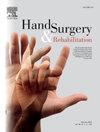Motec®全腕关节置换手术程序:个人珍珠和陷阱。
IF 1
4区 医学
Q4 ORTHOPEDICS
引用次数: 0
摘要
介绍了个人珍珠和陷阱,以及在手腕上进行Motec®假体手术的增强手术程序。虽然手术的目的是正确定位植入物,但标准化和细致的手术技术对于获得良好的结果和避免并发症至关重要,因为与该假体相关的学习曲线很大。对于手掌骨一侧,最重要的提示是通过“鞋盒”截骨术确保头骨得到充分释放,使其在所有平面上与第三掌骨对齐。同样重要的是要确保最终的掌骨螺钉延伸到第三掌骨髓内峡以外。在桡骨侧,桡骨螺钉必须定位正确,对准桡骨髓管,不能倾斜。短颈绝对不能使用。为了防止关节受到过度约束,提出了一种新的测试方法。当桡骨偏离时发生腕屈曲和手旋后,该试验呈阳性(病理)。最后,最重要的步骤之一是检查每个极端位置的凸轮效果。如果不能消除凸轮效应,可能会导致持续的疼痛,并随着时间的推移导致植入物松动。建议在第一次实施之前进行尸体实验室实践,或者有经验的外科医生在场,以尽量减少潜在的并发症。证据等级:治疗性5级。本文章由计算机程序翻译,如有差异,请以英文原文为准。
Motec® total wrist arthroplasty surgical procedure: personal pearls and pitfalls
Personal pearls and pitfalls are described, as well as an enhanced surgical procedure for performing Motec® prosthesis surgery on the wrist. While the objective of the procedure is to correctly position the implants, a standardized and meticulous surgical technique is crucial for achieving favourable results and avoiding complications, given the significant learning curve associated with this prosthesis. The most important tip for the carpo-metacarpal side is to ensure that the capitate is sufficiently freed through a 'shoe box' osteotomy, so that it is aligned with the third metacarpal in all planes. It is also important to ensure that the definitive metacarpal screw extends beyond the endomedullary isthmus of the third metacarpal. On the radial side, the radial screw must be positioned correctly, aligned with the radius medullary canal, and not tilted. The short neck must never be used. A new test has been proposed to prevent the joint from being overly constrained. This test is positive (pathological) when wrist flexion and hand supination occur during radial deviation. Finally, one of the most important steps is to check for a cam effect in every extreme position. Failure to eliminate cam effects can cause persistent pain and contribute to implant loosening over time. Cadaver lab practice is advised prior to the first implementation, or an experienced surgeon should be present, to minimize potential complications.
Level of evidence
Therapeutic Level 5.
求助全文
通过发布文献求助,成功后即可免费获取论文全文。
去求助
来源期刊

Hand Surgery & Rehabilitation
Medicine-Surgery
CiteScore
1.70
自引率
27.30%
发文量
0
审稿时长
49 days
期刊介绍:
As the official publication of the French, Belgian and Swiss Societies for Surgery of the Hand, as well as of the French Society of Rehabilitation of the Hand & Upper Limb, ''Hand Surgery and Rehabilitation'' - formerly named "Chirurgie de la Main" - publishes original articles, literature reviews, technical notes, and clinical cases. It is indexed in the main international databases (including Medline). Initially a platform for French-speaking hand surgeons, the journal will now publish its articles in English to disseminate its author''s scientific findings more widely. The journal also includes a biannual supplement in French, the monograph of the French Society for Surgery of the Hand, where comprehensive reviews in the fields of hand, peripheral nerve and upper limb surgery are presented.
Organe officiel de la Société française de chirurgie de la main, de la Société française de Rééducation de la main (SFRM-GEMMSOR), de la Société suisse de chirurgie de la main et du Belgian Hand Group, indexée dans les grandes bases de données internationales (Medline, Embase, Pascal, Scopus), Hand Surgery and Rehabilitation - anciennement titrée Chirurgie de la main - publie des articles originaux, des revues de la littérature, des notes techniques, des cas clinique. Initialement plateforme d''expression francophone de la spécialité, la revue s''oriente désormais vers l''anglais pour devenir une référence scientifique et de formation de la spécialité en France et en Europe. Avec 6 publications en anglais par an, la revue comprend également un supplément biannuel, la monographie du GEM, où sont présentées en français, des mises au point complètes dans les domaines de la chirurgie de la main, des nerfs périphériques et du membre supérieur.
 求助内容:
求助内容: 应助结果提醒方式:
应助结果提醒方式:


